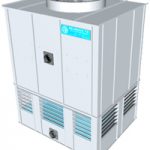Cooling towers
When within the industrial process there are thermal cycles required for its performance, it becomes necessary to remove any unused heat or excess heat that was produced, in order to continue performing the process. The non-eliminated heat would accumulate where it was produced and make it impossible to continue production until the issue is resolved.
The fluids most commonly used to cool industrial processes are air and water, due to them being the most available and economical. Both of these are used either directly – by cooling the user directly, or indirectly – by cooling other liquids (e.g. oils) which then cool the user.
Water can basically be cooled in three ways:
- Dry (radiators, dry refrigerator)
- Using a cooling device
- Wet, evaporation cycle
Wet cooling or evaporation is absolutely the most flexible and economical industrial water cooling system; and by far the most commonly used system in industries that have to cool large amounts of water. Machines that perform this type of cooling are known as “evaporation towers” or “cooling towers”.
They basically consist of: component housing, a water distribution system, the “filling”, a cooled water collection tank and a fan that produces air flow through the “filling”. In the filling, where the water that is being cooled and the air connector are in intimate contact, a small amount of water (about 4 – 5% of the flow) evaporates taking away heat from the remaining water.
Sectors in which cooling towers are used:
- Refineries
- Sugar (sugar industry)
- Distilleries
- Energy production (gas turbines, piston engines, etc.)
- Chemical industry
- Pharmaceutical industries
- Food
- Canning and juice industries
- Glaziers
- Ironworks
- Plastics industry
- Rolling mills and wire production
- Iron foundries
- Non-ferrous metals (manufacture)
- Heat treatment
- Paper mills
- Production of wood (veneered panels, etc.)
- Waste disposal (municipal solid waste)
- Purifiers (liquid)
- Wholesale of plumbing and heating equipment








